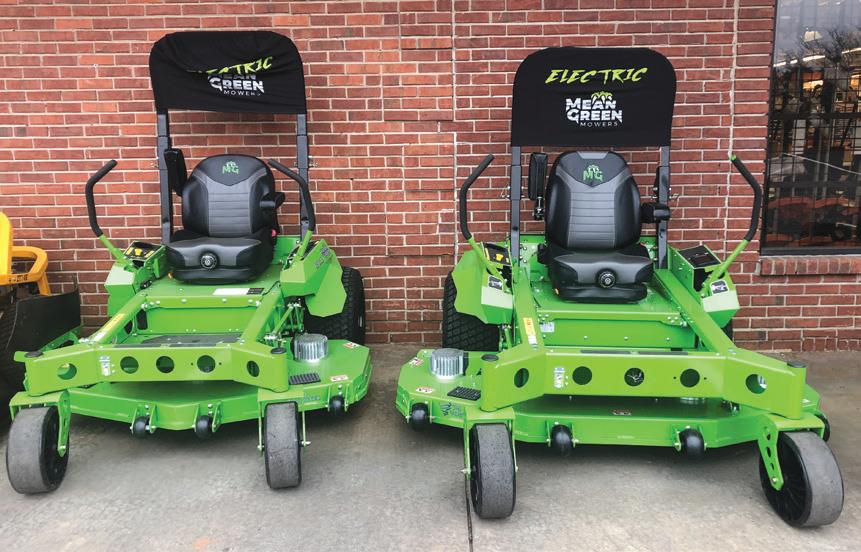
6 minute read
Busting three myths about battery power
Power, run time and how to implement in your business
by Sarah Webb, Landscape Management
Photo courtesy of SiteOne Landscape Supply “With the trend of electric vehicles in the automotive industry, they have really driven the improvements in our current battery technology that can be implemented within the green industry.”
~ Mike Gunn, President, Gunn Landscaping
Battery power has quietly been making
its way into handheld equipment for years, and many landscape professionals have reaped the benefits of using the tools.
“Landscape professionals enjoy battery (power) for the ease of use and not having to mix gas and oil; virtually no maintenance, such as fuel-related issues; reduced noise and vibration; and no exhaust emissions,” says Mike Poluka, product manager for Stihl. “Plus, (landscape pros) are often up against certain HOA or government regulations that prohibit the use of gas equipment. They need an alternative that satisfies that regulation and gives them the performance they need.”
While there’s still progress to be made, several experts agree that the technology will continue to improve in the years to come.
“I believe that the turning point for this new trend to really take off is right around the corner,” says Mike Gunn, president of Gunn Landscaping in Noblesville, Ind. “With the trend of electric vehicles in the automotive industry, they have really driven the improvements in our current battery technology that can be implemented within the green industry.”
Poluka, Gunn and Bob Grover, president of Pacific Landscape Management in Hillsboro, Ore., share their experiences using batterypowered handheld equipment to bust a few myths about battery power that still pervade the green industry.
MYTH #1
Batteries don’t generate enough power to compete with gas-powered equipment.
This year, Gunn Landscaping ran two gaspowered standard professional grade trimmers as well as Echo’s 58-volt trimmer all on the same trailer setup. Gunn says the 58-volt trimmer has as much as, if not more power, than the standard two-cycle alternatives.
“This was just to see if the battery power could take over as far as employee favoritism and convenience,” Gunn says. “It was also as easy as the pull of a trigger, and boom, you’re trimming. We need to remember that battery technology really is just as boundless if not more so as any combustion alternative and will only improve.”
Currently in the “experimental” phase of implementing battery-powered equipment into its daily operations, Gunn Landscaping uses battery-powered equipment from Stihl, Echo, DeWalt and Makita. The company provides lawn care, maintenance and design/build services to a 70 percent residential, 30 percent commercial clientele.
Grover, on the other hand, started implementing battery power at Pacific Landscape Management about three years ago, and he says the technology has come a long way as far as power.
“The first equipment we tried three years ago, the battery didn’t last as long, and it didn’t generate as much power,” he says. “I believe that the technology will continue to improve.” Pacific Landscape uses battery-powered blowers, string trimmers, hedge trimmers, edgers, chainsaws and hand tools like drills and saws. The equipment the company uses comes from a variety of manufacturers, including Stihl, Oregon and DeWalt.
“We’re wanting to stay on the forefront of technology, and we’re always curious when we see new developing technology come along,” Grover says. “The battery blowers in particular stem back to our environmental concern because small gas engines are very polluting, and if we can come up with a solution that is efficient and cost effective, we would love to lower our use of that polluting equipment in our operation.”
Overall, Grover says the biggest thing is to not give up on the idea of battery equipment.
“If we go back to electric cars of 10 years ago, now we have Tesla,” he says. “People were skeptical of cars, and you could go 150 miles. Now you can go 400. Let’s have faith in our manufacturers developing the technology to where it’s working and affordable.” Myth #2: Batteries can’t provide the run time to get through a full workday.

Photo courtesy of Howard Brothers "We need to remember that battery technology really is just as boundless if not more so as any combustion alternative and will only improve.”
~ Mike Gunn, President, Gunn Landscaping
MYTH #2
Overcoming the perception from previous battery technology that batteries can’t provide a full day of run time is a major challenge, according to Poluka.
Poluka says with old battery technology, certain tools would lose performance as the battery was depleting.
“(However), when you look to the new lithiumion technology, those batteries provide constant power throughout the whole state of charge,” he says.
While the batteries will offer the amount of run time landscapers can expect on a tank of fuel, they need to be able to recharge them. Therefore, Poluka says they should consider that they may need additional batteries in the fleet to be able to work throughout the day.
Gunn adds that while some users view battery power with great skepticism, he believes the introduction of the solid-state battery, which is
4
Pro tip
When considering battery-powered equipment, Gunn notes that landscape contractors should be aware that many of the batteries are brand specific.
“This forces you to choose a specific brand and stick with it as you grow and add various pieces of equipment within the same brand that those batteries can interchange within,” he says. “Do your homework and do the research necessary. Like anything, make sure you’re buying the right tool for the job. It’s no different from gas-powered equipment; there are different products for different applications.”
currently undergoing development in the auto industry, will bring the equipment one step further in addressing any run time issues.
“It is only a matter of time before that battery trickles down to other things like our handheld tools, mowers, etc.,” Gunn says. “This solidstate battery, which replaces liquid electrolytes with a solid, is really said to be the Holy Grail of battery technology. I feel that it will resolve a lot of the current issues with using lithium-ion.” He says the solid-state technology can last up to 30 years holding on to more than 90 percent of its original performance and can take far less time charging.
“So, if you can imagine, for example, your trimmers, when they are on the racks in the enclosed trailer and you are in between lawns, they can be essentially charging on a charging rack of some sort,” he says.
MYTH #3
Myth #3: Implementing battery power is an all-or-none scenario.
While there are many benefits to battery equipment, Grover says that at this point, companies should be wary of adopting an “all or none” attitude when it comes to the technology.
“It works on some routes, and it doesn’t work on other routes,” he says, noting that the company may not use all battery-powered equipment when it takes care of properties that have wide expanses.
On the other hand, when crews service small properties in downtown Portland, Ore., where they may go up elevators to access a site, they use battery-powered equipment.
He also notes that there is growing potential legislation, especially in certain municipalities in Oregon, to outlaw the use of small engine gas blowers, specifically. “We’re wanting to understand the battery equipment because it may become legislated that we would need to use it,” he says. “Banning gas-powered equipment before the technology gets there is challenging. I think with people that want to be sustainable, sustainability is a process we’re moving to. We need to be patient.”
About the author
Sarah Webb is Landscape Management's managing editor. She holds a bachelor’s degree from Wittenberg University, where she studied journalism and Spanish. Prior to her role at LM, Sarah was an intern for Cleveland Magazine and a writing tutor

Don't miss the UAC Short Takes video series!
Interviews with industry leaders - your fellow UAC members - as they discuss how they are meeting the challenges of COVID and keeping their employees and their businesses safe.










